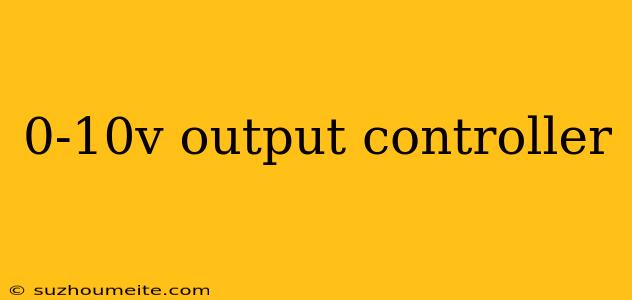0-10V Output Controller: Understanding the Basics and Applications
Introduction
In the world of industrial automation, process control, and building management systems, 0-10V output controllers play a crucial role in regulating and monitoring various parameters. These controllers are widely used to control valves, dampers, ballasts, and other devices that require a proportional output signal. In this article, we will delve into the basics of 0-10V output controllers, their applications, and how they work.
What is a 0-10V Output Controller?
A 0-10V output controller is an electronic device that generates a proportional output signal in the range of 0 to 10 volts. This output signal is used to control the operation of a device, such as a valve or a damper, in response to a measured parameter, such as temperature, pressure, or flow rate. The output signal is typically a DC voltage signal that is proportional to the input signal or setpoint.
How Does a 0-10V Output Controller Work?
The working principle of a 0-10V output controller is based on the concept of proportional control. The controller receives an input signal from a sensor or a setpoint, which is then compared to a desired setpoint. The difference between the two signals is calculated, and an output signal is generated accordingly.
The output signal is typically generated using a digital-to-analog converter (DAC) or a pulse-width modulation (PWM) technique. The output signal is then sent to the controlled device, such as a valve or a damper, which responds to the signal by adjusting its position or flow rate.
Applications of 0-10V Output Controllers
0-10V output controllers are widely used in various industries, including:
HVAC Systems
- Control of heating and cooling systems
- Regulation of air flow rates and pressure
- Control of dampers and valves
Process Control
- Control of flow rates and pressure
- Regulation of temperature and level
- Control of pumps and valves
Building Management Systems
- Control of lighting systems
- Regulation of heating and cooling systems
- Monitoring and control of energy consumption
Advantages of 0-10V Output Controllers
- High accuracy: 0-10V output controllers provide high accuracy and precision in controlling the output signal.
- Flexibility: These controllers can be used with a wide range of devices and systems.
- Reliability: 0-10V output controllers are designed to operate reliably in harsh industrial environments.
- Cost-effective: These controllers are often more cost-effective than other types of controllers.
Conclusion
In conclusion, 0-10V output controllers are an essential component in many industrial automation, process control, and building management systems. Their ability to provide a proportional output signal makes them ideal for controlling valves, dampers, and other devices. Understanding the basics and applications of 0-10V output controllers is crucial for designing and implementing effective control systems.
